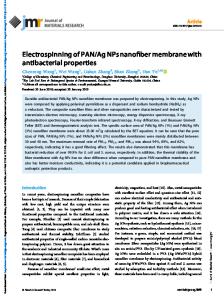Tailored Nanofiber Morphologies Using Modulated Electrospinning for Biomedical Applications
- PDF / 1,406,027 Bytes
- 6 Pages / 612 x 792 pts (letter) Page_size
- 42 Downloads / 514 Views
D3.8.1
Tailored Nanofiber Morphologies Using Modulated Electrospinning for Biomedical Applications David Y. Lin1, Michael A. Johnson4, Richard A. Vohden, Jr.2, Deborah Chen2 and David C. Martin1,2,3 1 Macromolecular Science and Engineering Center 2 Department of Materials Science and Engineering 3 Department of Biomedical Science and Engineering University of Michigan Ann Arbor, MI 48109, U.S.A. 4 Amgen Inc. Thousand Oaks, CA 91320-1799, U.S.A. ABSTRACT The process of electrostatic fiber formation, or electrospinning, was used to generate polymer filaments with diameters in the 50-200 nm range. We have shown that in addition to process parameters such as solution concentration, spinning voltage, and deposition distance, an oscillating electric field can also influence the morphology of the electrospun nanofibers. Specifically, effects of the oscillating field strength and frequency, spinning voltage, and deposition distance on fiber diameter as well as size and number density of the beaded structures in the fibrous thin films are examined. The results of our study demonstrate that modulated field potential produces more uniform fibers. Increasing either the oscillating field strength or frequency yields more uniform average fiber diameter. Also, for systems with the “beads on a string” fiber morphology, increasing the oscillating field strength produces more uniform bead sizes. The ability to tailor fiber morphology using an oscillating electric field has promising implications in a wide range of applications including controlled-release drug delivery systems and biocompatible implants. We show here the potential of using electrospun nanofibers as a porous template for growing fuzzy conductive polymers to modify the surface of a neural recording microelectrode device. These hairy nanostructures can increase signal transport and mediate the mechanical property differences between the device and the soft brain tissues. INTRODUCTION Electrospinning is the process of using electrostatic forces to distort a pendant droplet of polymer solution into a fine filament to be deposited onto a substrate [1] (see Figure 1). The polymer solution jet elongates in air and solidifies due to solvent evaporation. Due to the complex nature of this technique, many different materials properties and process variables can affect the morphology of electrospun nanofibers. The ability of this process to produce extremely fine fibers (from less than 3 nm to greater than 1 µm in diameter), as well as a number of interesting fiber morphologies has made it an attractive area of research for a number of different applications including the manufacturing of biopolymer nanofibers [2, 3], protective clothing systems, separation membranes [4], and tissue scaffolds [5, 6].
D3.8.2
Figure 1. Schematic diagram of the electrospinning process. Of particular interest to this study is the “beads on a string” morphology [7, 8]. Under specific processing conditions, electrospinning can produce bulbs of material at regular intervals along the axis of the nan
Data Loading...











